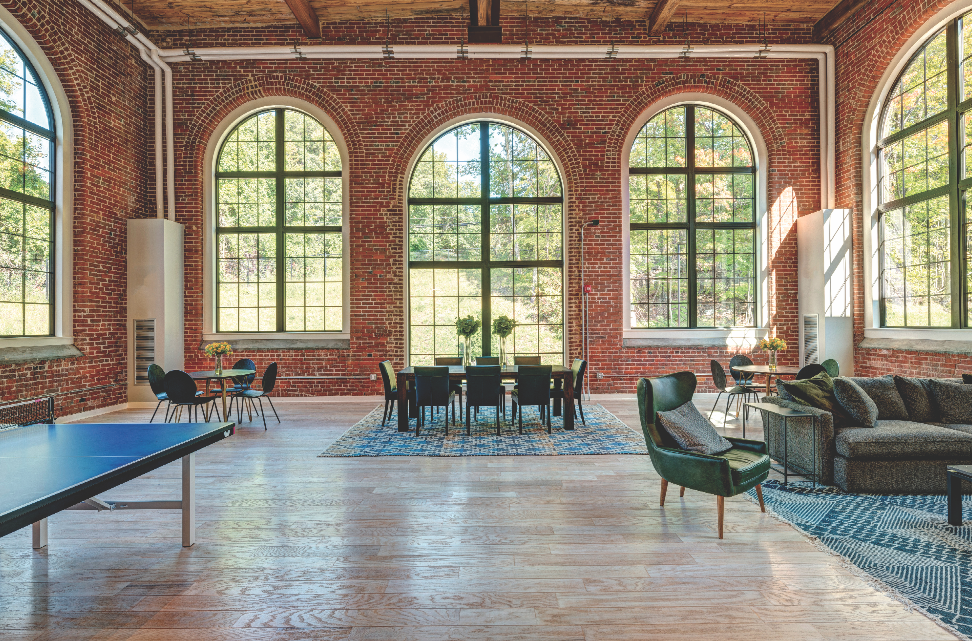Many small New England cities have a legacy of prominent early 20th-century brick mills that were built when industries like textiles, shoes, clocks, and machine parts thrived in the region.
These solid industrial buildings were built to last. Even after decades of neglect, with the right plan, design, and execution, they can become highly desirable living places.
Such is the case with two Massachusetts mill-to-apartment adaptations in Fitchburg and Ludlow. Both were designed by The Architectural Team (TAT), Boston, and developed by WinnDevelopment, the largest manager of affordable housing in the U.S., with 100,000 units in 22 states. Both projects showcase endearing early 20th-century elements—brick walls, old-growth wood beams, and steel staircases—while adding modern treatments and amenities that 21st-century multifamily tenants expect.
Yarn Works: Revitalizing Fitchburg
Located in north-central Massachusetts, Fitchburg has struggled economically for decades, but a commuter rail line connecting to Boston’s North Station—a 70-minute ride—and relatively affordable real estate may signal that a revival could be within its grasp.
The $24.2 million renovation of Yarn Works, a 182,500-sf vintage textile mill, is a step in that direction. Listed on the National Register of Historic Places, the three-story property, once known as the Nockege River Mill Building, offers 57 market-rate and 39 affordable loft homes. The mill sits on the banks of the Nashua River, just a mile from the city center.
The riverside provides a delightful network of walking trails and park space, but it also carries the threat of flooding. The Yarn Works property is in a 100-year flood zone, according to recent FEMA flood hazard mapping. Mitigating this risk was one of the chief environmental concerns faced by the project team, said TAT Project Manager Scott Maenpaa.
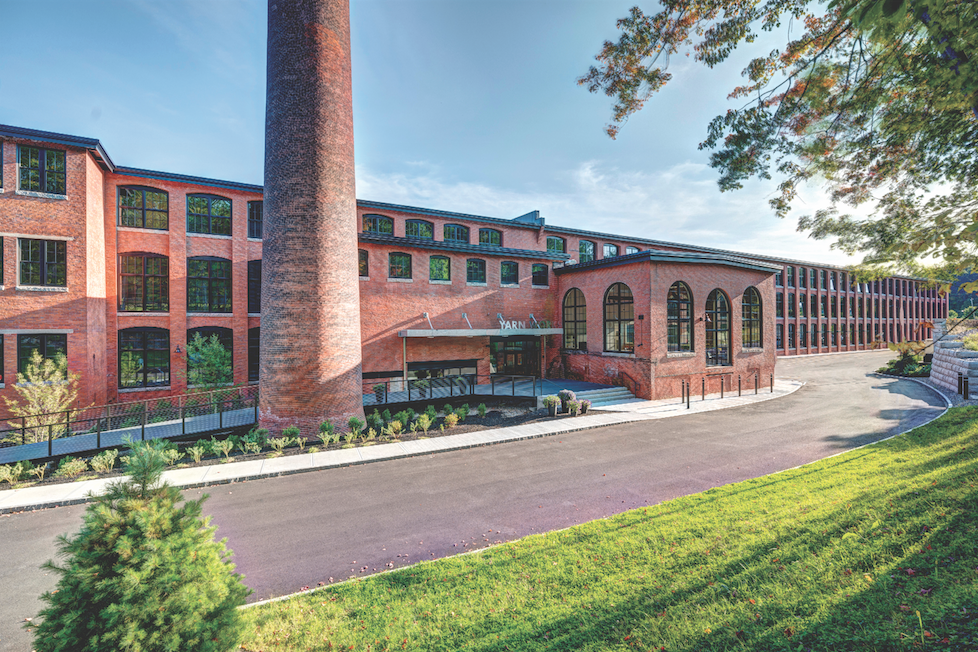
Nearly 300 8x12-foot steel sash-and-wood windows were replaced. New, thermally broken aluminum frames with historically matched muntins and divided-lite windows were installed to meet NPS standards. Photo: © Andy Ryan
Originally, water from the river was allowed to flow through the mill’s earthen basement, a situation that had to be rectified. The team’s initial option—filling in the crawlspace—was rejected because the crawlspace was part of the flood storage capacity on site. “If we were to fill it in, we would have had to create equal water storage capacity on site to offset it,” said Maenpaa. The solution devised by TAT, structural engineer ODEH Engineers, and GC Colantonio Inc.: raise the first floor about 27 inches using a steel and concrete deck.
The generous height of each floor (about 15 feet) and the placement of the large windows averted a potential major problem. After the floor was raised, a two-inch gap remained below the windows. Had the floor been raised even a few inches higher, it would have required altering the window dimensions or configuration, something that would have complicated adherence to historic standards.
With historic tax credits at stake, the National Park Service and state and local preservation agencies scrutinized the design plans to ensure that all exterior elements hewed closely to the original design. The existing 12-foot-high, eight-foot-wide wood windows were replaced with aluminum-frame windows that were sturdy enough to hold up to expected wind loads under current code. The aluminum windows’ thermally broken frames and brick molds, divided lite configurations, and historically matched muntins conformed to the old look, allowing them to pass muster with the Park Service.
The quest for historic accuracy went as far as an analysis of the mortar composition—aggregate, consistency, and color—to match the original recipe as closely as possible. Skilled masons replicated the concrete formula during an extensive repointing of brick walls to match the color and texture of the new mortar to the original.
Interior brick walls had been painted numerous times over the years. “Our vision for the interior, though, was to showcase the natural look of red brick and old-growth southern pine beams and columns,” said Maenpaa. The brick was delicately sandblasted to remove the lead paint. “It had to be done so that the brick would not be pitted,” Maenpaa said.
The existing wood floors were in poor condition and could not be saved. While covering them with hardwood would have met aesthetic and cost goals, that option was rejected for acoustic reasons. The exposed masonry and large windows, while gorgeous to look at, had little sound-absorbing qualities. This created an echo chamber that would have been made worse by hardwood, Maenpaa said. Sound-dampening attributes were added to the flooring system to prevent noise from walking and other normal activities from creating a din.
The design also called for leaving exposed the existing wood decking ceiling rather than installing a drop ceiling. That meant that the flooring had to provide all of the sound dampening between floors. A sound-absorbing mat (in this case, Quiet Qurl, from Keene Building Products), coupled with a gypsum floor underlayment (Maxxon’s Gypcrete), provided an effective sound (and odor) barrier.
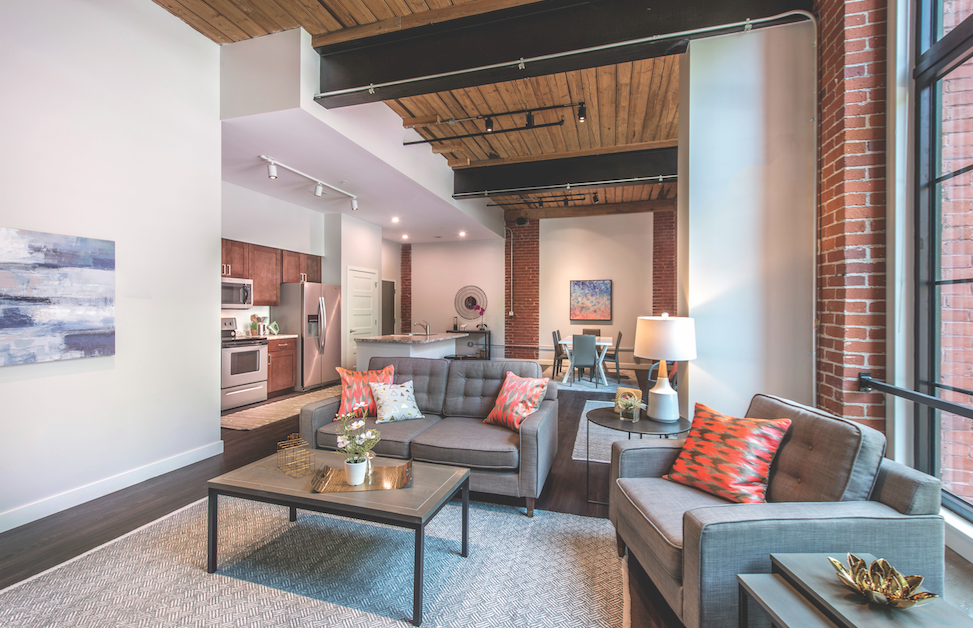
All 57 market-rate and 39 affordable loft homes at Yarn Works offer wood-plank ceilings and floors, exposed brick and original beams, and ceiling heights up to 15 feet. The $24.2 million renovation provided 29 one-bedroom, 58 two-bedroom, and nine three-bedroom apartments. Photo: © Gregg Shupe
Luxury vinyl plank flooring (from Turnaround Solutions) that mimics wood provided additional sound dampening and visually complemented the wood of the exposed ceiling deck. Hardwood flooring covers the common areas.
Many choices on interior finishes were set out by guidelines from the project’s funding agencies. These included high-grade laminate Formica 180fx countertops that mimic granite. In order to foster a clean indoor air environment, no carpeting was used. Low-VOC adhesives and no-VOC paints were specified. The cabinetry contained no urea formaldehyde products. Finishings were purposely kept minimal to reduce maintenance and expose the building’s architectural and structural elements.
The Massachusetts energy code requires a blower door test on each unit for buildings higher than three stories. To prevent air leakage, the units had to be compartmentalized from each other. (The layer of Gypcrete below the floor helped as well.) Exposed brick preserves the historic look and feel in the living room area walls. Bedrooms were insulated with closed-cell, high-density spray foam to enhance thermal efficiency. “About 40% of the walls in the building are insulated,” Maenpaa said.
The 3,000-sf lounge, which basks in the light of 17-foot-tall windows, has a community kitchen and a large-screen TV and seating area. (The kitchen countertop was crafted from Silestone, a quartz-like solid surface from Cosentino.) The dramatic space is defined by structural steel trusses, exposed brick walls, and 10-foot-high windows.
The Residences at Mill 10: Ludlow Rising
Just a short drive from Springfield, the Residences at Mill 10 are located in a 170-acre site along the Chicopee River, in Ludlow. The mill is one of more than 60 structures—including worker housing, schools, banks, and stores—built by the Ludlow Manufacturing and Sales Company, which over the course of 137 years produced jute yarns, rope, twine, and webbing. At its peak in the 1920s, the Ludlow complex occupied 1.2 million sf of mill and warehouse space.
The historic structure is a key element of the city’s Ludlow Mills Preservation and Redevelopment Master Plan. The four-story, 108,163-sf brick building, built in 1907, has much in common with the Yarn Works. It, too, is listed on the National Register of Historic Places; it, too, needed much of the same restoration work as the Fitchburg property—sandblasting and repointing the masonry, adding sound absorption to the flooring, and replacing more than 280 single-pane windows with double-pane aluminum historic replicas.
A significant difference in Ludlow was a large loading dock area in the rear of the first floor. Some of the first-floor units were expanded into this area, making them about twice the size of those in the floors above. “A lot of residents who moved in downsized from single-family homes, so these units offered extra space to make the move easier,” said Robert J. Verrier, FAIA, NCARB, TAT’s President, Managing Principal, and Founder. The bigger units have room for a formal dining area.
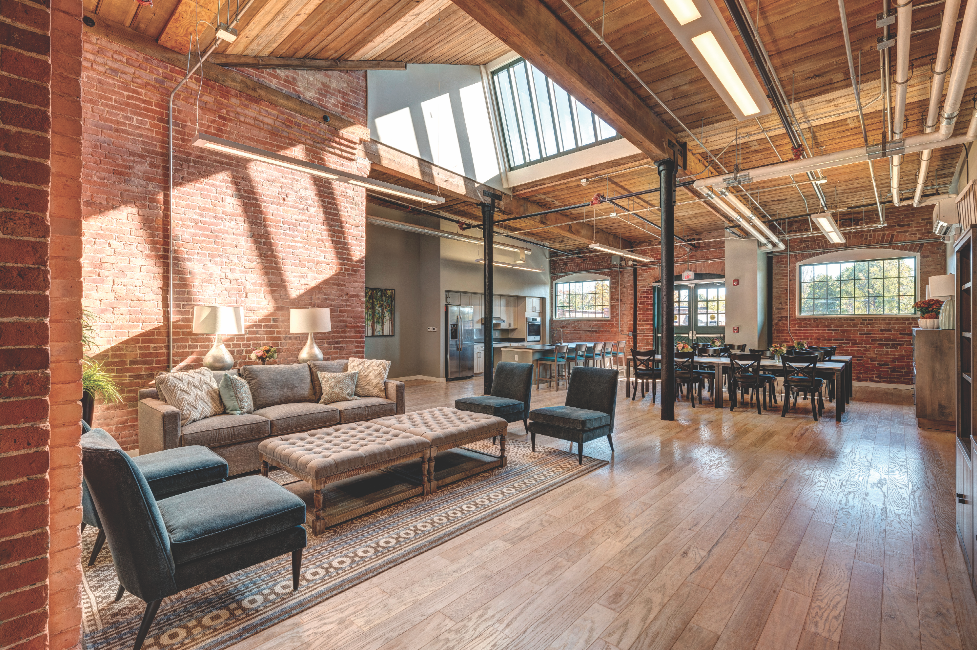
For the Residences at Mill 10 the renovation of the 108,000-sf former industrial facility required top-to-bottom structural work and restoration of the masonry façade. Exposed beams, high ceilings, and new historically matched windows characterize the interiors of the restored 1907-era mill, which is listed on the National Register of Historic Places. Photo: © Andy Ryan
The Ludlow property has a tenant lounge with a kitchen and TV viewing area on the first floor in the former loading dock area. Sawtooth skylights were preserved, allowing plenty of daylight to stream in. An outdoor patio provides additional seating off of the tenant lounge. There’s a fitness center and book nook, too.
The building’s main stair tower, a prominent feature at the main entrance, held up well over the years. “You could tell that it was the main point of egress for hundreds of mill workers,” Maenpaa said. “The treads had been worn down by as much as an inch.”
Planks salvaged from another century-old mill were used to replace the treads. The rails were cleaned and given a clear coat, leaving the refurbished staircase looking much as it had a hundred years ago.
A footbridge between the building and a neighboring structure was too low for modern fire equipment to pass under. But as part of the original structure it fell under historic review. “We had to bring a letter from the fire department to the National Park Service so that they would allow us to remove the bridge,” Maenpaa said.
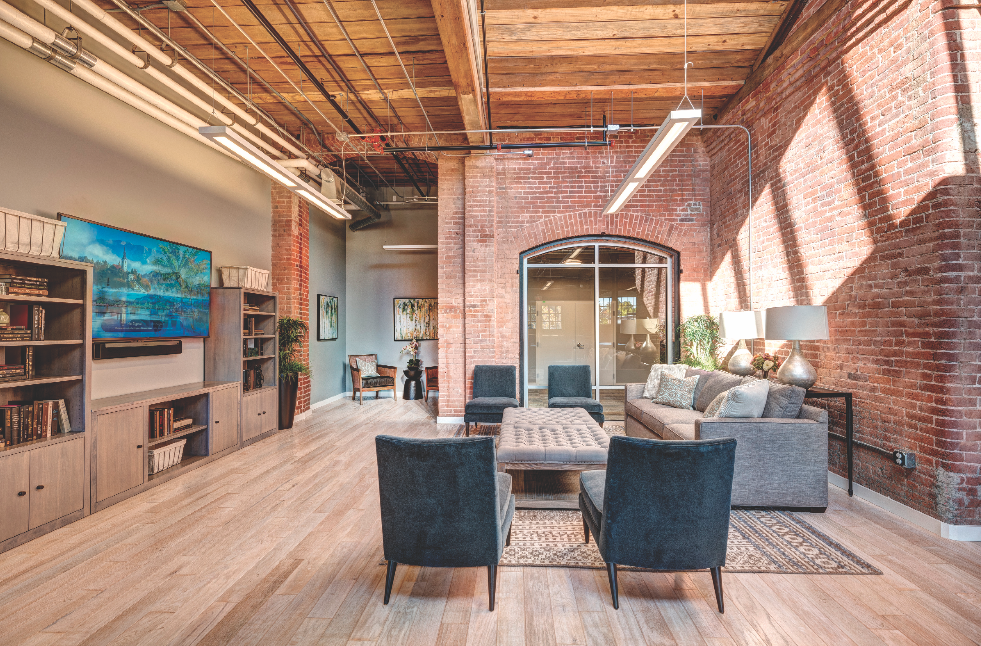
Amenities at the Residences at Mill 10 include community spaces and common areas on each of its four floors, a reading nook, a fitnes and yoga center, and a cybercafé lounge. Photo: © Andy Ryan
Once the bridge was demolished, a new stair tower, consisting of floor-to-ceiling glass and Castle Gray–colored metal panels, was constructed to provide additional egress.
The 63 one-bedroom and 12 two-bedroom units at the Residences at Mill 10 leased up in a flash. “There’s no doubt that the desire for quality housing for seniors in this region is strong,” said Lawrence H. Curtis, WinnDevelopment’s President and Managing Partner.
DOUBLING DOWN ON BENEFITS
The Yarn Works and the Residences at Mill 10 show how to bring century-old, architecturally intriguing structures up to modern code. Both buildings underwent seismic upgrades. Structural engineer ODEH Engineers added long spans of structural steel on the interior corners of the buildings to act as seismic ties. From both an environmental and economic perspective, they have achieved the best possible solution: saving two valuable historic edifices from the wrecking ball.
And there’s more to come. WinnDevelopment, which has completed more than 20 mill renovations across New England, has secured the rights to create up to 136 market-rate apartments, as well as commercial, retail, and office space, in the adjacent 231,000-sf Mill 8, known as the Clock Tower building.
PROJECT TEAM | YARN WORKS
Client: WinnDevelopment; Architect: The Architectural Team; Structural engineer: ODEH Engineers; General contractor: Colantonio, Inc.
PROJECT TEAM | THE RESIDENCES AT MILL 10
Client: WinnDevelopment; Architect: The Architectural Team; General contractor: Dellbrook Construction
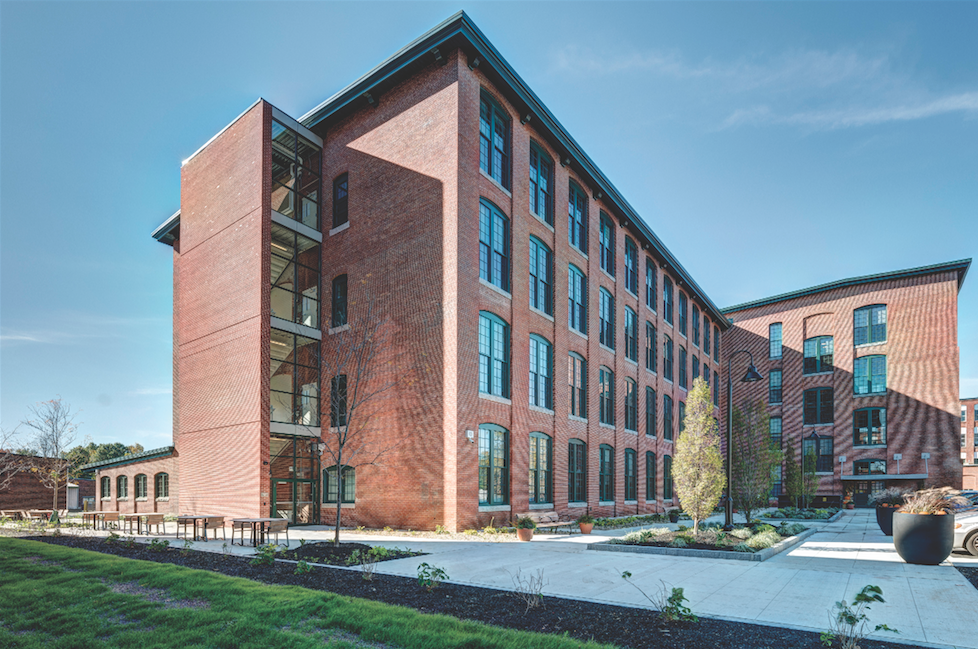
Residences at Mill 10. Photo: © Andy Ryan
Related Stories
| Aug 11, 2010
Oldcastle Precast Building Systems wins PCI 2009 Sustainable Design Award
Oldcastle Precast Building Systems was part of the award winning team behind the affordable housing development Melrose Commons Site 5 situated in the South Bronx. PCI (Precast Concrete Institute) recently selected Melrose 5 for the “2009 PCI Design Award for Best Sustainable Project”.
| Aug 11, 2010
National Intrepid Center of Excellence tops out at Walter Reed
SmithGroup and The Intrepid Fallen Heroes Fund (IFHF), a non-profit organization supporting the men and women of the United States Armed Forces and their families, celebrated the overall structural completion of the National Intrepid Center of Excellence (NICoE), an advanced facility dedicated to research, diagnosis and treatment of military personnel and veterans suffering from traumatic brain injury.
| Aug 11, 2010
USGBC honors Brad Pitt's Make It Right New Orleans as the ‘largest and greenest single-family community in the world’
U.S. Green Building Council President, CEO and Founding Chair Rick Fedrizzi today declared that the neighborhood being built by Make It Right New Orleans, the post-Katrina housing initiative launched by actor Brad Pitt, is the “largest and greenest community of single-family homes in the world” at the annual Clinton Global Initiative meeting in New York.
| Aug 11, 2010
Trump luxury condos in Jersey City get more luxurious
Only two years after opening, Jersey City-based Trump Plaza Residences is getting a facelift. Interior designer Benjamin Noriega-Ortiz of BNOdesign has been commissioned to create a fresh design for the residential tower's entrance and outdoor pool, cabana, and lawn spaces. Renovations on the 55-story, 443-unit luxury high-rise will be completed in two phases.
| Aug 11, 2010
Apartments offer skyline view of Houston
Perched atop a hill near downtown Houston, the Gables Memorial Hills residential tower will rise to eight stories and cover 2.68 acres. With an average unit size of 965 sf, the brick and cast-stone complex will consist of 70% one-bedroom units and 30% two-bedroom units, some of which overlook downtown.
| Aug 11, 2010
Sustainable features central to independent-living building
Architecture firm Perkins Eastman, together with Saint Johns on the Lake retirement community, plans to open a 21-story, 88-unit independent-living building for seniors by mid 2011. When the $46-million project is complete, it will offer residents a streetside café, art gallery, spa and wellness center, classroom, and community performance space.
| Aug 11, 2010
Historic building to be restored in Kansas City
Construction has begun on the conversion of the historic 17-story Home Savings Association building in Kansas City, Mo. The transformed structure, to be known as Grand Boulevard Lofts, will house 134 apartment units. The $18-million project, designed by architect Rosemann & Associates, follows a revitalization of downtown Kansas City, where there is high demand for affordable housing to ser...
| Aug 11, 2010
Old factory converted from hearth to home
A former briquette factory in Cologne-Frechen, Germany, was converted into a mixed-use building by Astoc Architects & Planners, Cologne, in association with Rheinischen Amt für Denkmalpflege—the Rhenish agency for historic preservation. The roughly 172,200-sf building includes a mix of residential condominiums, lofts, and leased commercial space.
| Aug 11, 2010
And the world's tallest building is…
At more than 2,600 feet high, the Burj Dubai (right) can still lay claim to the title of world's tallest building—although like all other super-tall buildings, its exact height will have to be recalculated now that the Council on Tall Buildings and Urban Habitat (CTBUH) announced a change to its height criteria.
| Aug 11, 2010
Luxury high-rise meets major milestone
A topping off ceremony was held in late October for 400 Fifth Avenue, a 57,000-sf high-rise that includes a 214-room luxury hotel and 190 high-end residential condominiums. Developed by Bizzi & Partners Development and designed by Gwathmey Siegel & Associates Architects, the 60-story tower in midtown Manhattan sits atop a smaller-scale 10-story base, which creates a street façade t...


